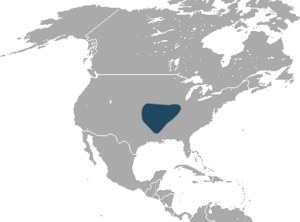Elliot's short-tailed shrew facts for kids
Quick facts for kids Elliot's short-tailed shrew |
|
|---|---|
 |
|
| Conservation status | |
| Scientific classification | |
| Genus: |
Blarina
|
| Species: |
hylophaga
|
 |
|
| Elliot's short-tailed shrew range | |
| Synonyms | |
|
Blarina carolinensis hylophaga |
|
The Elliot's short-tailed shrew (Blarina hylophaga) is a small, grey animal with a short tail. It's a type of shrew, which are tiny, mouse-like mammals. This shrew was named after Daniel Giraud Elliot, who first described it in 1899.
Contents
What Does Elliot's Shrew Look Like?
Elliot's short-tailed shrew looks a lot like its close relative, the southern short-tailed shrew. However, it is usually a bit bigger. This shrew has a strong body with short legs and a short tail. It also has a long, pointed nose with long whiskers.
Its ears and eyes are both small. Some of these shrews even have eyelids that are always closed. This is very unusual for a shrew.
Fur and Size
The shrew's fur feels soft and velvety. It is usually grey or brown all over. Adult shrews are about 9 to 12 centimeters (3.5 to 4.7 inches) long. This includes their tail, which is about 2 to 3 centimeters (0.8 to 1.2 inches) long. They weigh about 13 to 16 grams (0.46 to 0.56 ounces).
Where Does Elliot's Shrew Live?
Elliot's short-tailed shrew lives in low-lying areas with lots of plants. You can find them from southern Iowa and Nebraska down to parts of Texas and northern Louisiana. This area includes most of Missouri, Kansas, Oklahoma, and Arkansas. They are also found in the northeastern part of Colorado.
Shrew Subspecies
There are two types, or subspecies, of Elliot's short-tailed shrew:
- Blarina hylophaga hylophaga: This type lives in most of the shrew's range.
- Blarina hylophaga plumbea: This type is found only in Texas.
Shrew Habitats
These shrews live in many different places. This includes grasslands, farm fields, and forests. They usually like wet places with lots of leaves and plants on the ground. But they can also live in drier, sandy areas in Texas and Colorado.
How Elliot's Shrew Behaves and What It Eats
Like other shrews, this animal mainly eats insects. Its diet includes beetles and slugs. It also eats other insects, spiders, and earthworms. Sometimes, they might eat a small amount of plants and fungi. There have even been reports of them eating North American deermice. Owls, hawks, snakes, and swift foxes are some of their predators.
Daily Life and Hunting
Elliot's short-tailed shrew usually lives alone. It is a nocturnal animal, meaning it is active at night. During the day, it sleeps in burrows. These burrows are dug in soft soil or in piles of leaves. The burrows may have nests made from grass or leaves.
Around their burrows, shrews make a network of paths. They use these paths to hunt for food. They might travel across an area from 0.06 to 0.55 hectares (0.15 to 1.36 acres). They are most active around sunrise and sunset. Shrews have poor eyesight, so they hunt mainly by using echolocation. This means they use sound waves to find things. They stay active all year long and do not hibernate.
Elliot's Shrew Life Cycle and Reproduction
Elliot's short-tailed shrew breeds from early spring to late summer. A female shrew might have two or three litters of babies in one year. Pregnancy lasts about 21 or 22 days. Each litter usually has four to seven babies.
Young Shrews
When they are born, the young shrews are hairless. They start to get a fuzzy coat of hair and stop drinking milk by one month old. They don't get their adult fur until they are fully grown. These shrews can live for up to two years.
Elliot's Shrew Family Tree
Elliot's short-tailed shrew was first thought to be a type of Blarina brevicauda. But in 1981, scientists found it was its own separate species. Scientists have studied its genes to see how it is related to other shrews. Some studies show it is most closely related to the southern short-tailed shrew. Other studies suggest it is an older type of shrew compared to other species. The oldest fossils of this shrew are from the last Ice Age. The two subspecies might have become different types only about one thousand years ago.


